Abstract
This study aims to investigate alterations in the developmental parameters of Salvia splendens L., a commonly utilized seasonal flower associated with excessive water consumption in urban green spaces, through the implementation of deficit irrigation practices. Four distinct irrigation treatments, which entailed maintaining the evaporation pot’s water level at 100% (control), 75%, 50%, and 25% of the pot’s water-holding capacity, were established. This study scrutinized 18 growth parameters to assess the impact of varying water application levels. The findings of this research revealed that Salvia splendens L. plants exhibited more substantial improvements in 17 out of 18 assessed parameters when subjected to 75% water application (representing a 25% reduction in water supply) in comparison to 100% water application (with no reduction). Notably, the only parameter negatively affected by reduced water availability in Salvia splendens L. was the diameter of the flowers. Thus, it is recommended to reduce water application by 25% when cultivating Salvia splendens L. in urban areas. Such a measure is expected to yield substantial water conservation benefits in urban landscaping. Consequently, it is advisable to promote the frequent utilization of Salvia splendens L. plants in urban green spaces, given their robust development even under conditions of water scarcity.
1. Introduction
The escalation of global population, rapid urbanization, and the intensified density of agricultural and industrial regions have precipitated heightened competition for freshwater resources. This burgeoning water scarcity issue is particularly critical in urban areas, where landscaping plays a pivotal role [,]. Consequently, there arises a compelling imperative to prioritize water management within the realm of landscaping, emphasizing the dual goals of water conservation and enhanced irrigation efficiency [,,].
In light of the escalating impact of drought stress on plant viability due to irrigation restrictions, the selection of drought-resistant plant species has assumed increasing significance in the pursuit of sustainable landscape development []. Presently, the judicious use of water resources has become more paramount than ever, attributing to the limitation of water resources and the staggering consumption of 65–80% of available water for irrigation purposes [,]. Notably, the substantial water consumption in open green spaces, primarily aimed at sustaining plant life, underscores the imperative need for the judicious utilization of water resources in landscaping endeavors [].
The effective management of water resources has attained global prominence and holds equal relevance in the context of Turkey. Consequently, innovative approaches aimed at economically harnessing water resources for irrigating ornamental plants, especially within landscaping domains, have come to the forefront. Given that Turkey allocates a significant portion of its usable water resources, approximately 75%, for irrigation, comprehensive efforts are warranted to effectively plan existing water resources and promote their judicious use. The implementation of regulated irrigation practices during specific periods for ornamental plants known for their high water consumption in landscaping is an essential strategy for achieving water conservation [,].
Regulated irrigation, defined as the controlled allocation of water to plants, has gained extensive global recognition and application [,,,,]. Regulated irrigation signifies a methodology applied at prescribed levels and under specific protocols to ensure that it does not imperil plant well-being. Its primary objective is to achieve water savings while maintaining adequate irrigation. In the realm of regulated irrigation, water utilization efficiency is augmented, and productivity is minimally affected. A pivotal characteristic of regulated irrigation is the provision of a consistent water volume to plants, consequently enabling a higher yield per unit area [,].
The pivotal step in the quest for water-efficient landscaping lies in the planning and design phases. Prior to selecting plant species, an in-depth assessment of the physical and environmental conditions of the area is necessary to address existing challenges. Subsequently, a strategic evaluation of the purpose of the area, plant species selection, and classification of these species based on their water consumption rates is imperative [,,]. In the context of landscaping applications, a zoning strategy should be adopted where plants are categorized according to their water consumption levels, facilitating the informed placement of these plants based on their specific irrigation requirements [,].
While a plethora of research exists on regulated irrigation, most of these studies have predominantly focused on field and garden plants, such as Gossypium hirsutum L. [], Zea mays L. [], Beta vulgaris sp. [], Malus domestica Borkh. [], Solanum tuberosum L. [], Helianthus annuus L. [], and Olea europaea L. []. Remarkably, Demirel et al. [] have noted the insufficiency of studies focusing on the application of water restrictions to ornamental plants. Consequently, efforts have been directed toward exploring the influence of regulated irrigation on seasonal ornamental plants, including Zinnia elegans [], Petunia violacea [], Impatiens walleriana L. [], Cyclamen persicum Mill. [], Primula sp. [], Tagates erecta L. [], Chrysanthemum morifolium R. [], and Pelargonium domesticum [], with regards to their developmental patterns.
Gül et al. [] have underscored the high water consumption associated with seasonal flowers commonly used in urban areas []. In an effort to mitigate water consumption for irrigation purposes in urban zones, recommendations have been made to curtail the cultivation of seasonal flowers []. Nonetheless, it is acknowledged that seasonal flowers are indispensable components of the urban landscape [], contributing to the aesthetic enhancement of various areas such as parks, gardens, residences, woodlands, medians, intersections, squares, balconies, flower pots, roofs, and modular flower beds. Seasonal flowers bring forth a spectrum of colors and vitality to the urban landscape, ameliorating monotony, serving as space-fillers, and allowing for annual variations, all at a low cost. They boast prolonged flowering periods and are easily cultivated in greenhouses.
In a study assessing the impact of regulated irrigation on the developmental parameters of Tagates erecta, Sezen et al. [] observed that a 25% reduction in water had an insignificant impact on the number of flowers, chlorophyll content, plant height, leaf area, and root dry weight. In essence, there was no significant disparity between full irrigation and a 25% reduction in water application. Therefore, a 25% reduction in water usage holds the promise of cost savings. Uçar and Kazaz [], in their research on chrysanthemums, expounded on the significant influence of different irrigation practices on leaf area and the number of flowers. Furthermore, they noted that different irrigation strategies significantly affected the number of flowers in the Chrysanthemum morifolium R. plant. In their exploration of the effect of different irrigation levels on the vegetative characteristics of Pelargonium domesticum, Doğan et al. [] discerned that water scarcity expedited flowering.
The research hypothesis is rooted in the supposition that Salvia splendens L., a frequently employed seasonal flower in urban settings, receives an excess of water. This study seeks to ascertain that the application of controlled water restrictions at specific rates will not detrimentally affect plant growth parameters, thereby yielding water savings. The primary objective of this research is to scrutinize the impact of regulated irrigation systems on the developmental patterns of Salvia splendens L., a member of the Labiatae family, which holds an indispensable role in enhancing the seasonality of urban landscapes but has been subjected to superfluous water provision due to inadequate recognition of its actual water needs.
2. Materials and Methods
The research conducted in 2022 was situated within the confines of the Atatürk University Plant Production Application and Research Center Greenhouses. Salvia splendens L., a plant material renowned for its burgeoning commercial value in recent years, was selected as the subject of the study. Notably, the germination period for Salvia splendens L. seeds typically occurs between December and April, although in regions characterized by colder climates, sowing is recommended between March and April. On 1 March 2022, Salvia splendens L. F1 hybrid seeds, boasting a remarkable 90% germination rate, were sown. The growth medium utilized for planting the seeds was a blend of peat, fiber, and vegetable soil, comprising 65% peat and 35% soil content and characterized by an organic matter ratio of 75%. The pH value of this medium ranged from 5 to 7.
Salvia splendens L. seeds commenced germination approximately 9 days post-sowing, with significant germination occurring after 15 days. Once the plants attained a suitable size, they were transplanted into 5 L pots. Following the guidelines provided by [], the potting medium was composed of 2 parts loamy soil, 1 part peat, and 1 part sand, developed by the John Innes Horticultural Institute, a renowned source of superior growing mediums used for garden flowers. This experimental soil, formed by mixing washed and sieved river sand and peat in proportions of 50%, 25%, and 25%, respectively, was meticulously prepared to create the potting medium.
For the irrigation application, once the plants were transplanted into the pots, the soil was brought to field capacity (FC) for all subjects, and the irrigation levels were subsequently administered. With the exception of the control group, all other groups were subjected to irrigation at rates of 75%, 50%, and 25%, respectively. The initiation of both the control and irrigation groups was heralded by diversionary water applications.
The irrigation interval was determined based on the evaporation amount recorded from the evaporation pot until it reached a range of 5–10 mm. Consequently, irrigation was executed upon reaching the anticipated evaporation levels. The total evaporation amount was applied equally across the entire pot surface, with the entire evaporation quantity designated for the control group and 75%, 50%, and 25% allocated to the other groups.
The amount of water allocated to the control group was computed in accordance with Equation: I = kp × Ep × A
- I: Irrigation water (liter × pot– − 1)
- kp: Evaporation vessel coefficient (1 for control, 0.75–0.50–0.25 for other applications)
- Ep: Total evaporation read from the reduced evaporation pan (mm)
- A: Pot area (m2)
On 30 March 2022, the Salvia splendens L. plants were transplanted into 5 L pots, and six replications were conducted for each irrigation application. This resulted in six replications for each of the 25%, 50%, 75%, and 100% irrigation levels, totaling 24 pots of Salvia splendens L. plants. After potting, the plants were thoroughly watered to reach field capacity.
Subsequently, to monitor evaporation, a 60 cm diameter, 25 cm deep, and 15 cm high wooden base support unit made from 2 mm thick gray board was employed. Additionally, a custom water-filled evaporation measuring device, crafted specifically for this study by Atatürk University Central Workshops, was utilized. The measurement of evaporated water was achieved using a millimeter-scale wooden ruler. Furthermore, temperature and humidity measurements encompassing average, maximum, and minimum values were conducted employing a temperature-humidity measuring instrument.
Throughout the experiment, ambient temperature was maintained at a constant range of 25–30 °C, and irrigation was administered based on environmental evaporation rates. The study entailed the creation of four distinct irrigation scenarios, with each determined as a percentage of usable water holding capacity compared to the pot volume. Prior to the experiment, the pot capacity (field capacity) and usable water holding capacity (UWHC) of each pot were meticulously determined []. The pots were filled to their field capacity upon initial planting. The study continued by adjusting water application in subsequent stages based on the calculated evaporation, with the control group receiving 100% water and the other groups receiving 75%, 50%, and 25%. The intervals between irrigation applications were adapted depending on the evaporation levels.
It is noteworthy that the water used in this research was sourced from Atatürk University and was confirmed to be suitable for irrigation. Following the irrigation application, various growth parameters of the plants, such as the number of flowers, flower stem thickness, flower diameter, flower height, flower fresh weight, flower dry weight, leaf chlorophyll value, leaf area, root length, and root fresh weight, were meticulously observed and documented.
Cumulative evaporation levels were measured in millimeters using a modified (reduced) evaporation pot located within the greenhouse, and the water amount was presented in milliliters relative to the pot volume. The cumulative quantities of irrigation water applied to the flower seedlings, both in the control group and the other irrigation groups, over the course of the 55-day experimental period spanning from the seedling planting date (30 March 2022) to the final irrigation application (23 May 2022), were recorded in milliliters.
In this study, irrigation procedures commenced on 30 March 2022, with all pots brought to field capacity, and the research was successfully concluded on 23 May 2022. Over the duration of the trial period, a total of 319 mm of evaporation occurred from the evaporation pan. As a result, the daily average evaporation rate was calculated at 4.89 mm/day. In each irrigation group, 269 mm of irrigation water was allocated to the control group, whereas the other groups received 67.25 mm, 134.5 mm, and 201.75 mm at 25%, 50%, and 75% irrigation levels, respectively. The specific values pertaining to irrigation water and evaporation amounts applied during the research can be found in Table 1.

Table 1.
Irrigation water in research subjects (mm).
In the realm of seasonal floriculture, irrigation practices were enacted upon the attainment of a daily evaporation rate ranging between 5 and 10 mm within the confines of the greenhouse. As indicated in Table 1, this condition resulted in varying irrigation intervals, spanning from 1 to 3 days. The pinnacle of evaporation during the research occurred on 16 May 2022, registering an imposing rate of 21 mm/day for the control group. Conversely, the nadir of evaporation was noted on 6 May 2022, with a minimal rate of 3 mm/day for the control group.
Throughout the course of this study, the nexus between the recorded temperature, relative humidity, and evaporation levels was explored. This exploration was conducted between 30 March 2022, and 23 May 2022. It was observed that temperature and humidity levels remained constant in the region until April 20th. Subsequently, the upsurge in relative humidity, transpiring between 27 April 2022, and 15 May 2022, exhibited a clear correlation with temperature fluctuations. Notably, evaporation rates remained consistent during this period. The intricate interplay between evaporation, temperature, and humidity is illustrated in Figure 1.
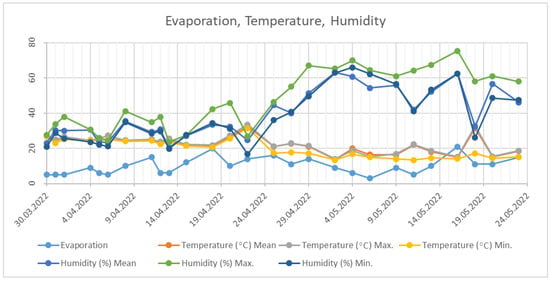
Figure 1.
The relationship between evaporation, temperature, and humidity.
The method flow chart is given in Figure 2.
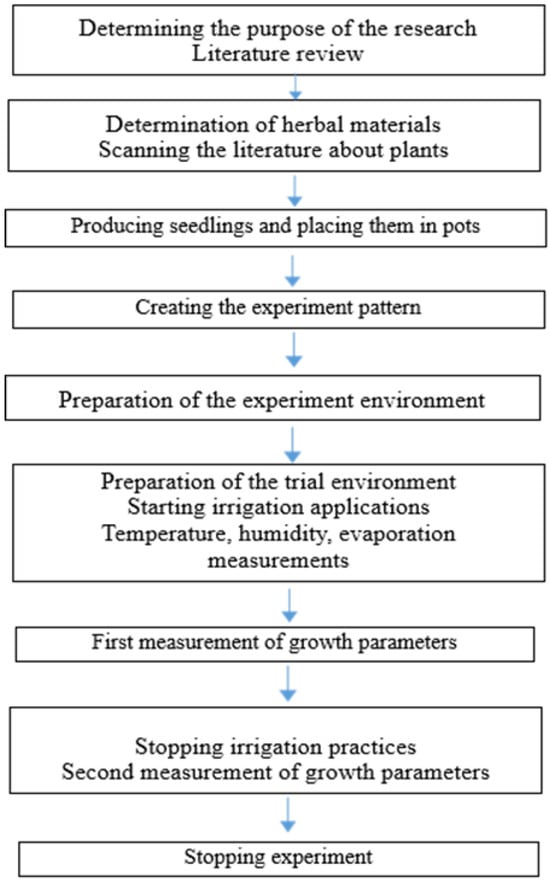
Figure 2.
Method flow chart.
3. Results and Discussion
The assessment of plant development involved the measurement of plant height, plant diameter, flower stem thickness, flower diameter, and flower height, which were performed using a digital caliper. Additionally, leaf chlorophyll values were quantified using a SPAD-502 chlorophyll meter on 29 April 2022, marking the 30th day following the initiation of water restriction on the seedlings. Furthermore, the count of new buds was meticulously determined.
Subsequently, on the 43rd day since the commencement of the water deficit conditions, a comparative analysis was conducted to scrutinize the plant growth of the replications that most aptly represented the distinct irrigation applications of Salvia splendens L. plants, encompassing 25%, 50%, 75%, and 100% irrigation levels. It is noteworthy that this particular section, while not obligatory, may be appended to the manuscript if the ensuing discussion entails intricacies or lengthiness beyond the ordinary scope.
The salient differences in the developmental trajectories of Salvia splendens L. plants in response to varying irrigation applications are visually depicted in Figure 3.
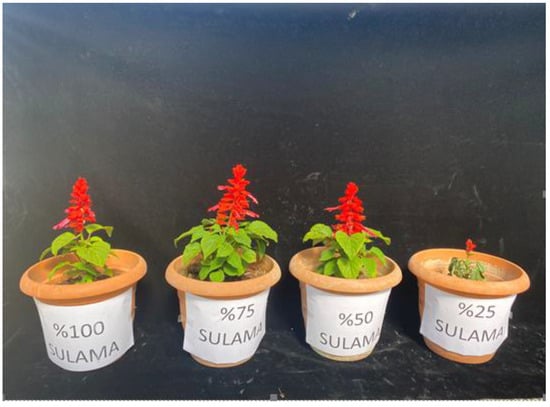
Figure 3.
Growth difference in the Salvia splendens L. plant according to irrigation applications.
In Table 2, the trial schedule of the Salvia splendens L. plant is given.

Table 2.
Trial schedule in Salvia splendens L. plant.
On the 55th day of the water scarcity period, a discernible phenomenon was recorded, whereby the Salvia splendens L. plants subjected to a 25% irrigation regimen exhibited signs of desiccation. Consequently, the experiment was promptly terminated, thereby discontinuing the water restriction regimen imposed on the Salvia splendens L. plants.
In the course of this experimental study, six repetitions of Salvia splendens L. plant applications with a 25% irrigation rate were conducted. In four of these repetitions, there was a complete absence of flowering, while one repetition yielded no instances of flowering, and in another repetition, the plant succumbed to its environmental conditions before reaching full maturation. Conversely, within all instances of plant applications featuring a 50% irrigation rate, flowering manifested on the 30th day subsequent to the initiation of the water scarcity period. In a consistent manner, across all six repetitions of applications with a 75% irrigation rate, flowering occurred on average after 62 days, commencing 56 days following the initial seed sowing. These findings substantiate that the provision of a 25% irrigation rate to Salvia splendens L. plants leads to a marked reduction in the flowering rate.
Moreover, it is noteworthy that within the group subjected to 75% irrigation, flowering occurred six days prior to the cohort exposed to 50% irrigation and four days earlier than the set receiving 100% irrigation. Although flowering was observed in all repetitions within the 50%, 75%, and 100% irrigation groups, it is evident that the 75% irrigation application, which corresponds to a 25% water restriction, demonstrated the most expedient onset of flowering. In Table S1, changes in growth values of The excerpt of Table S1 has been added to the main text. L according to irrigation practices and multiple comparison tests are given.
The impact of water restrictions on Salvia splendens L. plants was examined. On the 30th day of this restriction, a discernible disparity in the number of flowers was noted, with the application of 75% water (equivalent to a 25% water reduction) yielding the highest number of flowers in the first rank, followed by the 50% application in the second rank, and the 100% application in the third rank, while the 25% application exhibited a complete absence of flowering. Subsequent measurements conducted on the 55th day of the water shortage, which marked the conclusion of the experiment due to the desiccation of the 25% application group, corroborated these findings. Once again, the 75% water application ranked highest in terms of flower yield, followed by the 100% application in the second rank, the 50% application in the third rank, and the 25% application in the fourth rank. These outcomes underscore the superior effectiveness of the 75% water application (constituting a 25% reduction in water availability) in stimulating flower production. On the 30th and 55th days of this restriction, the highest number of flowers was found in the application where 75% water was applied, while the values in the other three water applications were quite low. This observation is aligned with the findings of Doğan et al. [], who similarly noted that water scarcity had an accelerating effect on flowering in their investigation assessing the impact of various irrigation levels on the vegetative characteristics of Pelargonium domesticum.
Moreover, measurements conducted on the 30th day of the water shortage indicated that the flower stem thickness was notably greater in the 75% water application, with the respective rankings as follows: 75% in the first rank, 50% in the second rank, 100% in the third rank, and 25% in the fourth rank. The measurements taken on the 55th day of the water shortage, in concurrence with the termination of the experiment due to the desiccation of the 25% application group, again affirmed the prominence of the 75% water application in terms of flower stem thickness. Specifically, the rankings in this instance were as follows: 75% in the first rank, 100% in the second rank, 50% in the third rank, and 25% in the fourth rank.
In the investigation concerning water restriction applied to Salvia splendens L. plants, the examination of various parameters revealed noteworthy findings. On the 30th day of water scarcity, it was observed that the flower diameter was greater in the group receiving 75% water in comparison to the other treatments. The respective flower diameters were ranked as follows: 75% in the first position, 50% in the second position, 100% in the third position, and 25% in the fourth position.
Subsequent measurements on the 55th day of the water scarcity period, which marked the termination of the experiment due to the desiccation of the 25% water application group, disclosed a different pattern. In this case, the highest flower diameter was found in the 100% water treatment group, followed by the 75% treatment in the second position, the 50% treatment in the third position, and the 25% treatment in the fourth position.
In her scholarly investigation of Chrysanthemum morifolium R., Turan [] observed that augmenting the water supply exhibited a favorable influence on both the yield and quality attributes. In a parallel context, on the 30th day of water restriction, the measurements revealed that flower height was significantly greater in the 75% water application group when compared to other treatments, with respective averages of 75% in the first position, 100% in the second position, 50% in the third position, and 25% in the fourth position.
Likewise, the measurement on the 55th day of the water scarcity period confirmed this trend, as the 75% water application group once again demonstrated the highest flower height, followed by the 100% treatment in the second position, the 50% treatment in the third position, and the 25% treatment in the fourth position.
In the realm of vegetative characteristics, measurements conducted on both the 30th and 55th days of the water scarcity period revealed that the plant height and diameter were superior in the 75% water application group (representing a 25% reduction in water supply) compared to other treatments.
The results of the water restriction study further indicated that the wet weight of vegetative parts on the 55th day was highest in the 75% water application group, followed by the 100% treatment, the 50% treatment, and the 25% treatment. Moreover, after the drying period following the 55th day of water restriction (23 May 2022), the measurements of dry weight showed that the 75% water application group yielded the highest dry weight for vegetative parts, followed by the 100% treatment, the 50% treatment, and the 25% treatment.
The leaf chlorophyll value of the Salvia splendens plant was measured on the 30th day of water curtailment, and the average chlorophyll value was higher in the application with 25% water compared to the application with 75% and 100% water, while it was lower than the applications with 50% water. The highest chlorophyll value was seen in the first rank with 50%, in the second rank with 25%, in the third rank with 75%, and in the fourth rank with 100%. Chlorophyll values were checked for the second time on the 55th day of the water shortage, and measurements could not be made because the plants were dry in 25% applications, while an increase in chlorophyll value was observed in 50% applications and a decrease in 75% and 100% applications. In the measurements made on the 55th day of the water shortage, the highest value in the average chlorophyll value was observed in the first order of 50%, in the second line of 75%, and in the third line of 100%. In the measurement made on the 55th day of the water shortage, an increase in the average chlorophyll value was observed in the 50% application and a decrease in the 75% and 100% applications. According to these results, in the Salvia splendens plant, with too much water restriction application, the chlorophyll value decreases to almost zero, while not applying any reduction (100% water application, 0% water reduction) also reduces the chlorophyll value. Adding water between 50 and 75% increases the chlorophyll value. As a matter of fact, Tüfenkçi [], in his study carried out to determine the effect of different levels of water restriction applications on some yield parameters of the quinoa plant, stated that the application of 50% less irrigation water compared to the application with 100% irrigation did not statistically lead to losses in yield. Kırnak and Doğan [], in their study to determine the effect of restricted irrigation on some quantitative parameters in the melon plant, stated that the effect of different irrigation water levels on chlorophyll under each irrigation system was found to be significant at the p < 0.05 level.
Furthermore, the number of plant shoots was directly influenced by the level of water scarcity, with an increase in water restrictions resulting in a decrease in the number of shoots. This outcome was in alignment with previous research by Curti et al. [] and Tufenkçi [], which noted that plants experienced reduced vegetative growth and shoot numbers under conditions of water stress.
Regarding leaf area, measurements were not feasible for the 25% water application due to leaf loss. Nevertheless, it was observed that the leaf area was largest in the 75% water application group, followed by the 100% treatment and the 50% treatment.
Additionally, on the 55th day of water scarcity, the number of new buds was highest in the 75% water application group, followed by the 100% treatment, the 50% treatment, and the 25% treatment.
The study also revealed that root length and root wet weight were greater in the 75% water application group compared to other treatments, indicating the efficacy of the 25% water restriction in promoting root development in Salvia splendens L. plants.
The application of the Duncan Multiple Comparison test has provided insight into the variations among irrigation treatments concerning the growth parameters of the Salvia splendens L. plant.
On the 30th day of the water scarcity period, the statistical analysis revealed significant differences among all groups with respect to the number of flowers (p < 0.05). However, in the measurements conducted on the 55th day of water shortage, the disparities in the number of flowers were not statistically significant between the 25%, 50%, and 100% irrigation applications, whereas a significant difference (p < 0.05) persisted between the 75% irrigation application and the remaining groups. Notably, the 75% irrigation application, representing a 25% reduction in water supply, yielded a higher number of flowers. It is pertinent to mention that Uçar and Kazaz [] similarly reported significant variations in the number of flowers in Chrysanthemum morifolium R. as a consequence of distinct irrigation practices.
Moreover, the analysis of flower stem thickness demonstrated no significant differences among the irrigation applications in the measurements made on the 30th day. Conversely, on the 55th day, the variances in flower stem thickness between the irrigation applications were highly significant (p < 0.01).
Likewise, the measurements on the 30th day indicated no substantial distinctions in flower diameter among the irrigation applications. However, on the 55th day, while the differences between the 75% and 100% irrigation applications and flower diameter were deemed insignificant, a highly significant difference (p < 0.01) persisted between these applications and the rest.
According to the Duncan Multiple Comparison test, on the 30th day, the distinctions in flower height among the irrigation applications were insignificant. On the same day, a significant difference (p < 0.05) was observed between the 75% irrigation application and the other groups. Yet, on the 54th day, the variance between the 75% and 100% irrigation applications and flower height was considered insignificant, whereas it remained highly significant (p < 0.01) when comparing these applications with the other groups. In a similar vein, Sezen et al. [] reported that plant height exhibited no significant alterations in a 75% water application (equivalent to a 25% water reduction), and a 50% water limitation did not adversely affect plant height.
Conversely, on the 30th day, there were no significant distinctions in plant diameter among the irrigation applications. However, on the 55th day, while the differences between the 50%, 75%, and 100% irrigation applications and plant diameter were considered insignificant, a highly significant difference (p < 0.01) was noted between the 25% application and the other groups. Doğan et al. [] also reported that different irrigation practices did not yield significant disparities in plant diameter values.
The leaf area measurements demonstrated insignificant differences among the 50%, 75%, and 100% irrigation applications. This finding aligns with the results of a study conducted by Sezen et al. [], who found that the variance in leaf area between a 75% water application and a 100% water application was statistically insignificant.
The number of buds showed no significant distinction between the irrigation applications.
However, in terms of the dry weight of the vegetative parts, there were significant differences (p < 0.05) among all applications.
According to the Duncan Multiple Comparison test, leaf area measurements made on the 55th day revealed no significant differences between the irrigation applications.
Furthermore, on the 55th day, the differences in the number of plant shoots between the 50%, 75%, and 100% irrigation applications were deemed insignificant. However, a highly significant difference (p < 0.01) was observed between the 25% application and the other groups.
Root length, root fresh weight, and root dry weight displayed no significant differences among the 50%, 75%, and 100% irrigation applications. Conversely, the variance between the 25% application and the other groups was considered significant (p < 0.05). This observation resonates with the findings of Ekinci and Başbağ [], who suggested that water limitation fosters root development. In accordance with Kaçar [], the accelerated development of the main root in the cotton plant under drought conditions serves as an indicator of the plant’s ability to reach soil moisture.
In summary, the Duncan Multiple Comparison test has elucidated the significant and insignificant variations in growth parameters resulting from distinct irrigation practices applied to the Salvia splendens L. plant. These findings provide valuable insights into the plant’s response to water restriction and its impact on various growth aspects.
Effective use of water resources has become increasingly important all over the world and in Turkey. For this reason, new approaches aiming at the economical consumption of water used in irrigating ornamental plants, especially in landscape areas, have come to the fore. One of these approaches is that in Turkey, where a large proportion of usable water resources, such as 75%, is used for irrigation purposes, many intermediate steps need to be taken for the planning of existing water resources and effective water use. Deficit irrigation approaches should be developed in certain periods for ornamental plants that consume a lot of water and are used in landscape areas. With deficit irrigation approaches, water savings should be ensured [,].
Deficit irrigation is an irrigation approach applied at certain levels and processes, provided that it does not endanger the plant. Its main purpose is to save water by making adequate use of irrigation. In deficit irrigation, water use efficiency is increased and productivity is minimally affected. The most important feature of deficit irrigation is to obtain more income per unit area by giving the same amount of water to the plant and irrigating more area with the increased water [,,].
In summary, the findings underscore the nuanced effects of varying water application rates on multiple aspects of Salvia splendens L. plants’ growth and development. The relationship between these parameters and the overall water application rates is graphically presented in Figure 4.
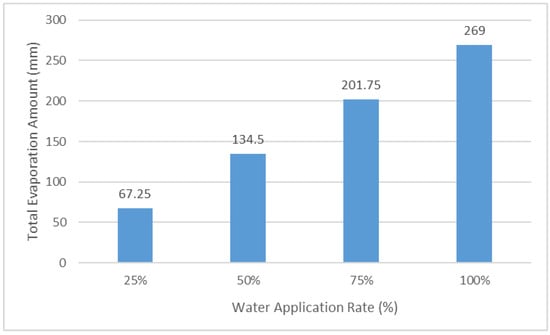
Figure 4.
The relationship between the total evaporation amount and water application rates.
The respective values for flower stem thickness (30th), flower diameter (30th), and flower length (30th) within each irrigation treatment are depicted in Figure 5.
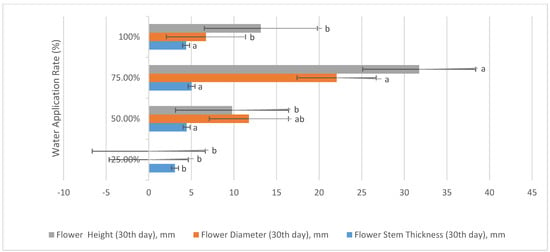
Figure 5.
Flower height (30th day), flower diameter (30th day) and flower stem thickness (30th day) values for each irrigation application (Letters a, b indicate statistical difference).
The number of flowers (30 days) and number of flowers (55 days) values for each irrigation application are given in Figure 6.
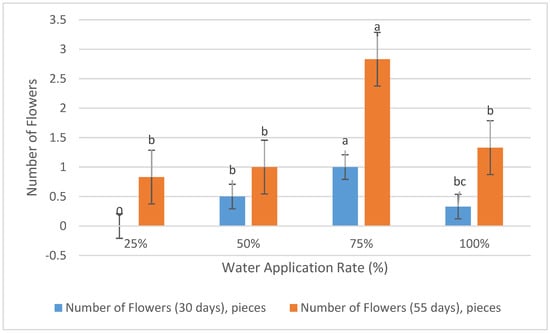
Figure 6.
Number of flowers (30 days) and number of flowers (55 days) values for each irrigation application (Letters a, b, c indicate statistical difference).
Flower stem thickness (55th), flower diameter (55th), and flower length (55th) values for each irrigation application are given in Figure 7.
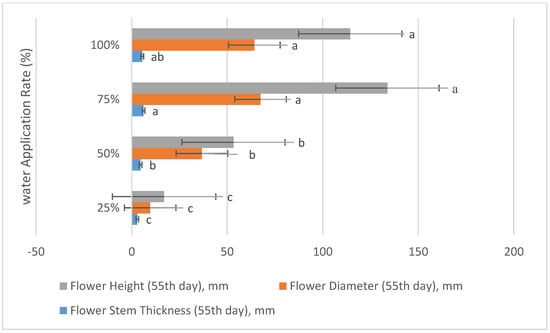
Figure 7.
Flower height (55th day), flower diameter (55th day) and flower stem thickness (55th day) values for each irrigation application (Letters a, b, c indicate statistical difference).
Flower dry weight and flower fresh weight values for each irrigation application are given in Figure 8.
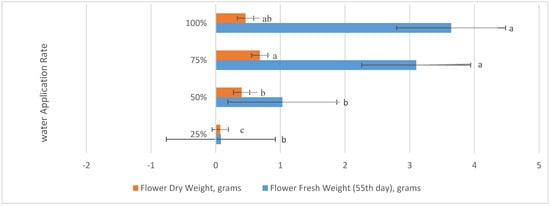
Figure 8.
Flower dry weight and flower fresh weight values for each irrigation application (Letters a, b, c indicate statistical difference).
Leaf chlorophyll value (55th day) and leaf chlorophyll value (30th day) values for each irrigation application are given in Figure 9.
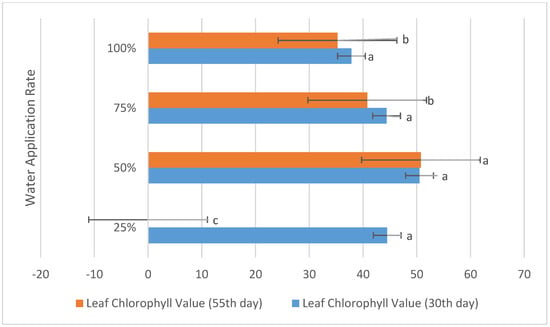
Figure 9.
Leaf chlorophyll value (55th day) and leaf chlorophyll value (30th day) values for each irrigation application (Letters a, b, c indicate statistical difference).
The figures illustrating the plant height values on the 30th and 55th days for each irrigation treatment are provided in Figure 10.
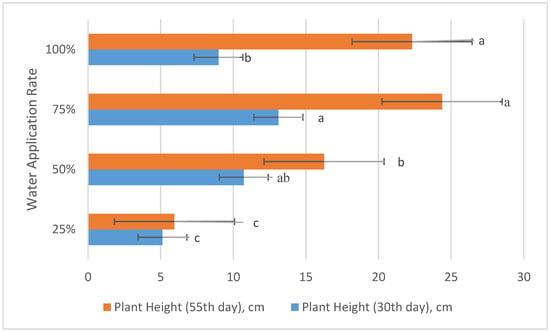
Figure 10.
Plant height (55th day) and plant height (30th day) values for each irrigation application (Letters a, b, c indicate statistical difference).
Plant diameter (55th day) and plant diameter (30th day) values for each irrigation application are given in Figure 11.
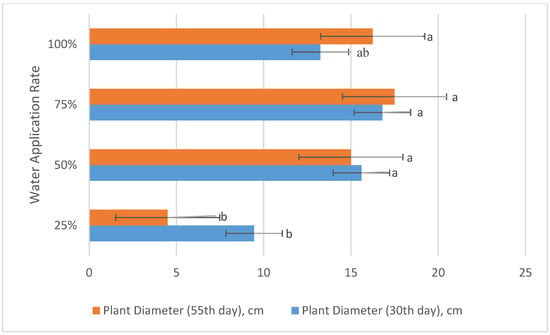
Figure 11.
Plant diameter (55th day) and plant diameter (30th day) values for each irrigation application (Letters a, b indicate statistical difference).
The vegetative part dry weight and vegetative part wet weight values for each irrigation application are given in Figure 12.
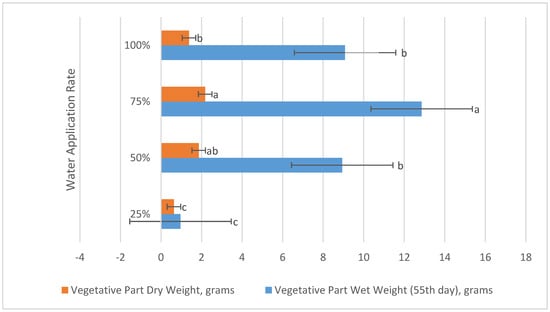
Figure 12.
Vegetative part dry weight and vegetative part wet weight values for each irrigation application (Letters a, b, c indicate statistical difference).
Root dry weight and root fresh weight values for each irrigation application are given in Figure 13.
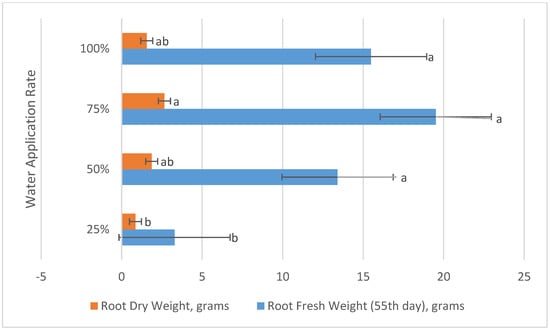
Figure 13.
Root dry weight and root fresh weight values for each irrigation application (Letters a, b indicate statistical difference).
4. Conclusions
Seasonal flowers, a commonly utilized element in urban landscaping, are well-recognized for their substantial water consumption. Among these seasonal flowers, Salvia splendens L. stands out as the most prevalent choice. It is noteworthy that the existing literature indicates a scarcity of comprehensive studies addressing water restriction practices in ornamental plants. This study was conducted to address this research gap, with the aim of investigating the impacts of diverse water application regimes across 18 parameters related to plant growth.
Within the growth parameters, the difference between 75% irrigation and 100% irrigation in the parameters of number of flowers (30th days), number of flowers (55th days), flower stem thickness (30th days), flower stem thickness (55th day), flower diameter (30th day), flower length (30th day), flower length (55th day), flower dry weight, plant height (30th day), plant diameter (30th day), vegetative part wet weight (55th day), vegetative part dry weight, leaf area, root length (55th day), and root dry weight was statistically significant. It was observed that the values of growth parameters were higher with 75% irrigation. Although the difference between 75% irrigation and 100% irrigation in other parameters is not statistically significant, it is seen that the growth parameters in 75% irrigation have higher values than the development parameters in 100% irrigation. As a result, it was observed that 75% irrigation (25% water reduction) positively affected the growth parameters of the Salvia splendes plant. Especially in Salvia splendens L., the factors negatively affected by water scarcity were the fresh weight of the flower (day 55) and the number of plant shoots (day 55). Notably, the only aspect negatively affected by the water shortage in Salvia splendens L. was the development of flower diameter. Consequently, the results underscore the favorable influence of a 75% water application, presenting a 25% water reduction, on overall plant growth in Salvia splendens L., outperforming the results of a 100% water application with no water reduction.
In light of these findings, it is recommended to implement a 25% reduction in water when incorporating Salvia splendens L. in urban landscaping. This strategic approach not only fosters significant water conservation but also encourages the widespread adoption of Salvia splendens L. in urban environments, contributing to water-saving initiatives.
Supplementary Materials
The following supporting information can be downloaded at: https://www.mdpi.com/article/10.3390/w15234187/s1, Table S1: Changes in growth values according to irrigation applications in Salvia splendens L. andmultiple comparison test.
Author Contributions
I.S., A.K. and S.Y. were responsible for composing the main manuscript text; S.Y. conducted statistical analysis; and I.S., S.Y., E.A.K. and A.K. conducted the greenhouse studies as part of the research. All authors have read and agreed to the published version of the manuscript.
Funding
This research was supported by Atatürk University Scientific Research Projects Coordination Unit as a Basic Research Project with the code FBA-2021-9142.
Data Availability Statement
Data are contained within the article and supplementary materials.
Acknowledgments
We would like to thank Atatürk Uni-versity Scientific Research Projects Coordination Unit for their support. The authors express their gratitude to the Atatürk University Scientific Research Projects Coordination Unit for their invaluable support.
Conflicts of Interest
The authors declare no conflict of interest.
References
- Lea-Cox, J.D.; Ross, D.S. A review of the federal clean water act and the Maryland water quality improvement act: The rationale for developing a water and nutrient planning process for container nursery and greenhouse operations. J. Environ. Hort. 2001, 19, 226–229. [Google Scholar] [CrossRef]
- Cai, X.; Starman, T.; Niu, G.; Hall, C.; Lombardini, L. Response of Selected Garden Roses to Drought Stress. Hortscience 2012, 47, 1050–1055. [Google Scholar] [CrossRef]
- Nicolas, E.; Ferrandez, T.; Rubio, J.S.; Alarcon, J.J.; Sanchez-Blanco, M.J. Annual water status, development, and flowering patterns for Rosmarinus officinalis plants under different irrigation conditions. Hortscience 2008, 43, 1580–1585. [Google Scholar] [CrossRef]
- Niu, G.; Rodriguez, D.S.; Cabrera, R.; McKenney, C.; Mackay, W. Determining water use and crop coefficients of five woody landscape plants. J. Environ. Hort. 2006, 24, 160–165. [Google Scholar] [CrossRef]
- Evsahibioğlu, N.A.; Akhüzüm, T.; Çakmak, B. Water Management, Water use strategies and transboundary waters, Turkish Agricultural Engineering VII. Tech. Congr. 2010, 1, 119–134. [Google Scholar]
- Bayramoğlu, E.; Ertek, A.; Demirel, Ö. Approach The Deficit Irrigation in Landscape Architecture for Water Conservation. İnönü Univ. J. Art Des. 2013, 3, 45–53. [Google Scholar]
- Barış, M.E. Arid Landscape. Sci. Tech. J. 2007, 478, 22–27. [Google Scholar]
- Sezen, I.; Yağanoğlu, S.; Akpınar Külekçi, E.; Karahan, A. Effect of Restricted Irrigation on Developmental Parameters of Tagates erecta Plant. The Increasing Need for Adaptation to a Rapidly Changing Environment: The Challenges of Agriculture; Polat, T., Okant, M., Eds.; İKSAD Publishing House: Ankara, Turkey, 2023; pp. 55–76. [Google Scholar]
- Trimmer, W.L. Applying partial irrigation in Pakistan. J. Irrig. Drain. Eng. 1990, 116, 342–353. [Google Scholar] [CrossRef]
- English, M.J.; Musich, J.T.; Murty, V.V.N. Deficit irrigation. In Management of Farm Irrigation Systems; Hoffman, G.J., Howell, T.A., Soloman, K.H., Eds.; ASAE: St Joseph, ML, USA, 1990. [Google Scholar]
- Jurriens, M.; Wester, P. Protective Irrigation in India; 1994 Annual Report; International Institute for Land Reclamation and Improvement: Wagenmgen, The Netherlands, 1994. [Google Scholar]
- Çetinkale Demirkan, G.; Akat, H. Water Efficient Landscape Arrangements Approaches in Arid Regions ‘Xeriscape’. In Proceedings of the 3RD ASM International Congress of Agriculture and Environment, Antalya, Turkey, 16–18 November 2017. [Google Scholar]
- Sezen, I.; Esringü, A.; Yardımcı, K. Water Efficient Use for Sustainability of Water Resources in Urban Areas: Xeriscape. Kent Akad. 2018, 11, 474–485. [Google Scholar]
- Çorbacı, Ö.M.; Özyavuz, M.; Yazgan, M.E. Water-wise in Landscape Architecture: Xeriscape. J. Agric. Sci. Res. 2011, 4, 25–31. [Google Scholar]
- Ektiren, Y.; Değirmenci, H. Effect of Deficit Irrigation Applications on Plant Leaf Nutrition Elements of Cotton (Gossypium hirsutum L.). KSU J. Agric. Nat. 2018, 21, 691–698. [Google Scholar] [CrossRef]
- Gençoğlan, C.; Yazar, A. The Effects of Deficit Irrigations on Corn Yield and Water Use Efficiency. Turk. J. Agric. For. 1999, 23, 233–241. [Google Scholar]
- Süheri, S.; Topak, R.; Yavuz, D. The Effects of Different Irrigation Regimes on Yield and Water Use Efficiency of Sugar Bee. Selcuk. J. Agric. Food Sci. 2007, 21, 37–45. [Google Scholar]
- Emre, M.; Küçükyumuk, C.; Yıldız, H. The effect of periodic restricted irrigation practices on income in apple production. Derim 2016, 33, 77–92. [Google Scholar] [CrossRef]
- Ayas, S. Water-Yield Relationship of Limited Irrigated Potatoes. Ph.D. Thesis, Uludağ University Institute of Science and Technology, Bursa, Türkiye, 2007. [Google Scholar]
- Gençoğlan, C.; Gençoğlan, C.; Akbay, C.; Uçan, K. Deficit Irrigation Analysis in Sunflower (Helianthus annuus L.). KSU J. Sci. Eng. 2005, 8, 138–144. [Google Scholar]
- Camoglu, G. The effects of water stress on evapotranspiration and leaf temperatures of two olive (Olea europaea L.) cultivars. Zemdirb.-Agric. 2013, 100, 91–98. [Google Scholar] [CrossRef]
- Demirel, K.; Camoğlu, G.; Akcal, A.; Genç, L.; Nar, H. Investigation of the Effects of Different Irrigation Levels on Plant Properties of Zinnia. In Proceedings of the 1st International, 14th National Congress on Agricultural Structures and Irrigation, Antalya, Turkey, 26–28 September 2018. [Google Scholar]
- Riaz, A.; Martin, P.; Riaz, S.; Younis, A.; Hameed, M. Comparative performance of two zinnia (Zinnia elegans) cultivars under high-temperature and limited water conditions in Pakistan. In Proceedings of the I International Trials Conference: Assessment of Ornamental Plants, Wisley, UK, 4–7 July 2011; Volume 980, pp. 69–78. [Google Scholar]
- Shams, J.; Najafi, P.; Etemadi, N.; Shams, A. Effects of irrigation levels on morphology and physiology characteristics of Petunia violacea. Res. Crops 2012, 13, 307–310. [Google Scholar]
- Andersson, N.E. The influence of water stress and air velocity on growth of Impatiens walleriana and Petunia x hybrid. Sci. Hortic. 2011, 128, 146–151. [Google Scholar] [CrossRef]
- Demirel, K.; Çatıkkaş, G.R.; Kesebir, B.; Çamoğlu, G.; Nar, H. Determination of Changes in Physiological and Morphological Properties of Cyclamen in Different Water Stress Levels. J. Agric. Fac. Bursa Uludag Univ. 2020, 34, 55–70. [Google Scholar]
- Demirel, K.; Yıldırım, D.; Ayanoğlu, Z.; Albayrak, F.; Kuşak, İ.; Ersoy, Ç.; Budak, N.B.; Nar, H.; Çamoğlu, G.; Akçal, A.; et al. Investigation of the Effects of Water Stress on Morphological and Physiological Properties of Primula. COMU J. Agric. Fac. 2020, 8, 347–358. [Google Scholar]
- Uçar, Y.; Kazaz, S. Effects of Different Irrigation Schedulings on Quality of Chrysanthemum. J. Agric. Sci. 2016, 22, 385–397. [Google Scholar]
- Doğan, S.; Demirel, K.; Çamoğlu, G.; Nar, H.; Akçal, A. Determination of the Effects of Different Irrigation Levels on the Plant Characteristics of Regal Geranium. Lapseki Vocat. Sch. J. Appl. Res. 2020, 1, 1–15. [Google Scholar]
- Gül, A.; Özçelik, H.; Uzun, Ö.F. The Characteristics and Adaptation of Some Native Groundcover Plants in Isparta Province. Isparta Province. Süleyman Demirel Univ. J. Nat. Appl. Sci. 2012, 16, 133–145. [Google Scholar]
- Yazıcı, N.; Dönmez, Ş.; Kuş Şahin, C. Evaluation in terms of Xeric Landscape Design of Some Plants Used in Landscape Designs in Isparta. Kastamonu Univ. J. For. Fac. 2014, 14, 199–208. [Google Scholar]
- Çetin, N.; Mansuroğlu, S. Determination of Plant Species can be used in Xeriscape design under Mediterranean conditions: The Sample of Antalya/Konyaaltı. J. Agric. Fac. Ege Univ. 2018, 55, 11–18. [Google Scholar]
- Alp, Ş.; Onat, İ.; Kubik, M. Ornamental Plants Production Techniques and Care Requirements; Istanbul Metropolitan Municipality Parks and Gardens Green Areas Department Publications: Ankara, Türkiye, 2011; 156p.
- Oral, N.; Açıkgöz, E. Garden Flowers; Çevre Publications, 1991; 171p. [Google Scholar]
- Turan, A. The Effect of Different Irrigation Interval and Water Amount on Yield and Quality Parameters of Chrysanthemum (Chrysanthemum morifolium Ramat). Master’s Thesis, Süleyman Demirel University Graduate School of Applied and Natural Sciences, Isparta, Turkey, 2013. [Google Scholar]
- Tufenkci, S. The Effect of Different Levels of Water Deficit on Some Yield Parameters of Quinoa. Eregli J. Agric. Sci. 2021, 1, 27–37. [Google Scholar]
- Kırnak, H.; Doğan, E. The Effects of Deficit Irrigation on Some Quantitative Parameters of Muskmelon with Subsurface and Surface Drip Irrigation Systems. J. Agric. Fac. Gaziosmanpasa Univ. 2017, 34, 80–86. [Google Scholar]
- Curti, R.N.; Andrade, A.J.; Bramardi, S.; Velásquez, B.; Daniel Bertero, H. Ecogeographic structure of phenotypic diversity in cultivated populations of quinoa from Northwest Argentina. Ann. Appl. Biol. 2012, 160, 114–125. [Google Scholar] [CrossRef]
- Ekinci, R.; Başbağ, S. Determination of Effects of Deficit Irrigation on Some Morphological Properties of Cotton (G. hirsutum L.). Yüzüncü Yıl Univ. J. Agric. Sci. 2019, 29, 792–800. [Google Scholar]
- Kaçar, M.M. Examination of the Change of Water Stress Index in Cotton Plant of Different Water and Fertilizer Systems. Master’s Thesis, Çukurova University Institute of Science, Adana, Turkey, 2007. [Google Scholar]
Disclaimer/Publisher’s Note: The statements, opinions and data contained in all publications are solely those of the individual author(s) and contributor(s) and not of MDPI and/or the editor(s). MDPI and/or the editor(s) disclaim responsibility for any injury to people or property resulting from any ideas, methods, instructions or products referred to in the content. |
© 2023 by the authors. Licensee MDPI, Basel, Switzerland. This article is an open access article distributed under the terms and conditions of the Creative Commons Attribution (CC BY) license (https://creativecommons.org/licenses/by/4.0/).